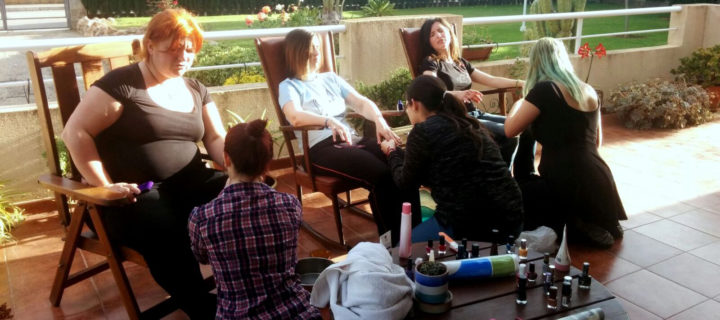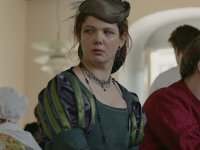A couple of months ago, I received my copy of #Feminism: A Nano-Game Anthology. It took me only two days to read all the games, and I was very excited about testing a lot of them.
So, first of all, I needed to figure out how to set up a time and place where we could play. I realised that some of the games are written to be played by only women but others required the presence of men for play to be the most interesting. The second problem was choosing a space. We (as Producciones Gorgona) don’t have a meeting place so, we needed to find one.
After thinking a lot about it, we highlighted the characteristics of the place we need:
- Two or more rooms (so we can play at least two games at the same time).
- Intimate
- Places we could sleep
So, finally, to avoid paying a lot of money, I decided to offer my parents’ house in the countryside. We could sleep there, it was big enough, and it was intimate. In addition, we decided to go for a whole weekend of feminism games, where Saturday and Saturday night would be for women only, and the Sunday the men would be welcome.
And we did so last weekend (May 14-15, 2016). We loved all the games we had time to test. So, I will not focus this review on the anthology as a whole, but on our experiences of running the games we chose.
Reviewing #Feminism: A Nano-Game Anthology
Selfie
Selfie is a game written by Kira Magrana. It’s part of the section called ‘The Digital Age’. We consider it a very good way to create trust and to form a new group (we knew each other but not very well). And it worked quite well!
The game consists of taking some selfies and trying to guess what feelings we wanted to convey. I’m not going to explain it here (you’ll have to get the amazing book for that). But I want to give you some advice if you’re going to run it.
- If you decide to use the soundtrack proposed by the author, you can find it already prepared in my Spotify account so you don’t have to make it again.
- During the game, we discovered that it was funnier if we not only tried to guess the feeling by naming it, but also tried to build the history behind them by using hashtags.
- We played it with 7 players (not the 3 to 5 recommended in the book), and it worked smoothly. So don’t be afraid to increase the number to adapt to the group you have.
After lunch, we divided into two groups to play simultaneously. Three of us (myself included) played My Sister Malala (me included) and the other four went to the other terrace to play Mum, I Made This Sex Tape.
My Sister Malala
My Sister Malala is a game designed by Elsa Helin. It’s a free form for only three players. In this game, you play one of three Pakistani teenagers who can use the Internet in their schools, and the different lives they experience. Each of them has two scenes: a Facebook state and its conversation, and a short live-role playing scene.
We only made two changes to the original design. The first one was starting the Facebook conversation with an actual written status just below the Facebook page we designed in the workshop (we decided not only to describe the photos, but also to draw them). We think that helps to reenact how a real Facebook post is. After that, we continued the conversation orally, as described in the game.
The second change was to the short scenes. According to the designer, all the players have to decide together how the scene will end. In Spanish larp culture, this is a very strange concept. We prefer playing the larps without knowing the ending, going with the flow of events. So we agreed to adapt it. Before the scene began, the other two players (non-protagonists ) talked about how they would play their characters and how they wanted to finish it. The entire scene was therefore a surprise for the main character, in the same way that it would have been for a real teenager. I think this change worked marvelously.
Overall, I think the design is very solid. The way in which it creates a scale of tension and identification with the different girls was amazing. I totally recommend playing it if you can.
Mum, I Made This Sex Tape
The other four girls played Mum, I Made This Sex Tape, designed by Susanne Vejdemo. I can’t review this larp completely, as I didn’t play it. One of the players who did provided this review:
Four of us decided to play this game due to the topic, which is funny and taboo at the same time. The game is designed for 3-5 players with pre-written characters. One of them is a girl who has made a sex tape and is proud of it but she wants to know the opinions of other female members of her family.
It is a good way to know the evolution of feminism from its beginnings, through the role of the grandmother, until today thanks to the role of the girl. All the characters are strong in their convictions about the way women should live and think about sex and porn.
If you want to play this game, here are some tips:
-With 4 players, it is better to include the aunt rather than the sister. It will be very refreshing and good support for the girl.
-Don’t create tense relationships. Mother and aunt should be sisters, not sisters-in-law.
-We played for 20 minutes and it was too short! We could have played for at least 10 more minutes.
-And most importantly: enjoy every moment and have fun.
Mentioning the Unmentionables
After two hard games, we decided to play something more light-hearted; our choice was Mentioning the Unmentionables by Kajsa Greger. It was the funniest game I’ve ever played, especially the first two parts.
As with the other games, we wanted to play all together, so we adapted the game for seven players. It wasn’t a problem for the two first games (“Vulvas” and “Dying for a cup of coffee”) but it was for the last one (“Just Put Some Salt on It”). Since you have to replay each scene three times, the game can run very long if you play with more than five people.. As the games can be played separately, I highly recommend to playing the first two with more people if you like, but not the third one.
“Vulvas” is an easy game, but so much fun. We nearly doubled the number of objectives, so we were very happy about it (afterwards, we continued with it all day long when we remembered a new film). For Spanish speakers that want to play this game, we translated the word “vulva” for “vagina” as the meaning in Spanish is funnier (The Spanish tend to be more open about saying some words, such as “coño” (c***) – and “vulva” is like a high level word for us).
I’m not going to say much about the other two games, as they should be played without knowing the twists they have. However, if you need a game that is funny but at the same time addresses important issues , Mentioning the Unmentionables is your choice. It is time for women’s anatomies, problems and needs to be called by their true names.
Glitzy Nails
Later, we came together again and decided to play Glitzy Nails, designed by Kat Jones. Glitzy Nails explores the relations between women of different social classes, and how their problems are not only different but also they separated them in the fight for women’s rights.
The larp is for 2 or 4 players, but we decided to play with 6 (3 clients and 3 workers). Moreover, as we were 7, two of them played as one (one played the immigrant and the other the executive). Also, it is not a problem to increase the number of players in pairs (2, 4, 6, 8…), I highly recommend not playing it in pairs; it is more interesting if you can play both roles.
We decided to make other changes to the settings. According to the design, you must play it at a table, as manicures are done in most Western countries. But, based on our experiences visiting countries in Southeast Asia such as Vietnam and Cambodia, we put out three armchairs for the clients and we did the manicures on our knees. It increases the feeling of humiliation and the differences between the roles. It worked very well (even all of us had pain in our legs the day after).
For me, this game was one of the better designed in the book. It was well thought-out, well written, and it was even better when we played it. We could totally understand how women lose everything when they leave their native countries to find a new life.
Flesh
Writing about Flesh is, maybe, the hardest thing I’ve ever done. Flesh is designed by Frederik Berg, Rebecka Eriksson and Tobias Wrigstad, and it turned out to be the strongest experience of the weekend – even a life-changing one for most of us. Trying to write a review without telling personal histories thus becomes difficult.
First of all, Flesh it’s not a larp. It’s more like therapy. And it’s only for women (trans or cis), at least the way we played it. It requires a private space and a certain level of trust between the players. We weren’t exactly sure about how to play it (if we had to do it all together, the timing of each action…).
This is why we adapted the game in a way we think it could work. Maybe, when you read it, you will realise we were totally wrong about it. Yes, we admit that.
We played it in turns. Each of us chose a song that really meant something to them so they could – literally – bare their bodies and souls. Once we did that, we wrote on our bodies the problems we have with them, and our strengths. We objectified ourselves to the point of being nothing but a body. After that, the other players erase our writing for us while explaining why it is not important, letting us be only flesh.
It was wonderful, and terrifying. We discovered things about ourselves that we had never realised before. We opened our souls, and let others in. We became broken, but managed to rebuild ourselves in a newer, stronger way.
6066
Writing about 6066 after Flesh is hard, because they are two totally opposite experiences. 6066 is a comedy larp written by Elin Nilsen. We played it on Sunday morning, once some guys and other girls had shown up. Even if it’s supposed to be from 3 to 6 players, there were 11 of us. I think it is a larp that can be scaled up, but I don’t recommend more than 8 (there were too many people for some of the actions).
I have to admit that it was one of the most appealing larps for me. As a PhD in archaeology, I’m personally interested in how you can know a society by the things they left behind. In that way, using a soap opera was a really amazing way to highlight the gender role problems we are leaving behind.
On the other hand, it was hilarious to play. We were inspired by the South American soap operas (the most common in Spain) and we translated the title as: “Amor, Lujuria y Desconfianza”. One of our friends composed the entire song for the credits, and we were singing it for days.
I have to confess that we played it for nearly two hours, but it was so much fun. The mechanic of changing between the soap opera and the students seeing it, and being able to stop, pause and rewind was very well designed. Totally recommended.
Conclusion
We found all the games of #feminism that we played very interesting. It was a pity we didn’t have more time on Sunday to play more of them (we wanted to test Catcalling and A Friend in Need with the guys). So we decided two important things: first of all, we’ll have to play them another day; second , the girls will meet once a year, alone, to enjoying this amazing experience. We hope to design our own games next time.
It was an incredible experience for us (the girls who spent the whole weekend). After that, we have become like sisters; we have shared too much to not having real bonds – something special. And that’s something that money cannot buy.
#Feminism: A Nano-Game Anthology was released in 2016 after a successful crowd-funding campaign. You can read more about it here: https://feministnanogames.wordpress.com/
#Feminism has also been chosen to be part of the E3 IndieCade 2016: http://www.indiecade.com/games/selected/feminism








